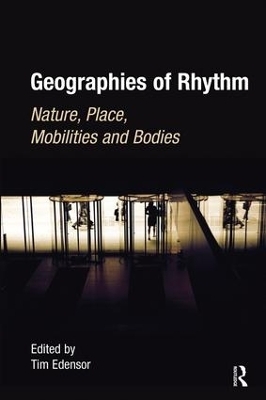
Geographies of Rhythm
Routledge (Verlag)
978-0-7546-7662-1 (ISBN)
In Rhythmanalysis, Henri Lefebvre put forward his ideas on the relationship between time and space, particularly how rhythms characterize space. Here, leading geographers advance and expand on Lefebvre's theories, examining how they intersect with current theoretical and political concerns within the social sciences. In terms of geography, rhythmanalysis highlights tensions between repetition and innovation, between the need for consistency and the need for disruption. These tensions reveal the ways in which social time is managed to ensure a measure of stability through the instantiation of temporal norms, whilst at the same time showing how this is often challenged. In looking at the rhythms of geographies, and drawing upon a wide range of geographical contexts, this book explores the ordering of different rhythms according to four main themes: rhythms of nature, rhythms of everyday life, rhythms of mobility, and the official and routine rhythms which superimpose themselves on the multiple rhythms of the body.
Dr Tim Edensor is Reader in Cultural Geography at the Department of Environmental and Geographical Sciences, Manchester Metropolitan University, Manchester, UK
Chapter 1 Introduction: Thinking about Rhythm and Space, Tim Edensor; Part I Power and the Rhythms of Place; Chapter 2 Consuming Urban Rhythms: Let’s Ravalejar, Monica Degen; Chapter 3 Life Hacking and Everyday Rhythm, Tracey Potts; Chapter 4 The Aesthetics of Place-temporality in Everyday Urban Space: The Case of Fitzroy Square, Filipa Matos Wunderlich; Part II Resisting Rhythms; Chapter 5 Urban Outreach and the Polyrhythmic City, Tom Hall; Chapter 6 Fascinatin’ Rhythm(s): Polyrhythmia and the Syncopated Echoes of the Everyday, Deirdre Conlon; Chapter 7 ‘I’m in a Park and I’m Practically Dead’: Insomnia, Arrhythmia and Withnail and I, Craig Meadows; Part III Mobile Rhythms; Chapter 8 ‘He Who Thinks, in Modern Traffic, is Lost’: Automation and the Pedestrian Rhythms of Interwar London, Richard Hornsey; Chapter 9 Improvising Rhythms: Re-reading Urban Time and Space through Everyday Practices of Cycling, Justin Spinney; Chapter 10 Repetition and Difference: Rhythms and Mobile Place-making in Santiago de Chile, Paola Jiron; Chapter 11 ‘The Engine Sang an Even Song’: Rhythm and Mobilities among Early Women Aviators, Dydia DeLyser; Part IV Dressage and Bodies; Chapter 12 Rumba and Rhythmic ‘Natures’ in Cuba, Shannon Hensley; Chapter 13 Equine Beats: Unique Rhythms (and Floating Harmony) of Horses and Riders, Rhys Evans, Alexandra Franklin; partV Rhythms and Socio-Natures; Chapter 14 ‘The Breath of the Moon’: The Rhythmic and Affective Time-spaces of UK Tides, Owain Jones; Chapter 15 Re-thinking Catastrophe in the Timeof Climate Change, James Evans;
| Erscheint lt. Verlag | 28.2.2010 |
|---|---|
| Verlagsort | London |
| Sprache | englisch |
| Maße | 156 x 234 mm |
| Gewicht | 612 g |
| Themenwelt | Naturwissenschaften ► Biologie ► Ökologie / Naturschutz |
| Naturwissenschaften ► Geowissenschaften ► Geografie / Kartografie | |
| Sozialwissenschaften ► Soziologie ► Allgemeines / Lexika | |
| Technik ► Architektur | |
| ISBN-10 | 0-7546-7662-5 / 0754676625 |
| ISBN-13 | 978-0-7546-7662-1 / 9780754676621 |
| Zustand | Neuware |
| Haben Sie eine Frage zum Produkt? |
aus dem Bereich


